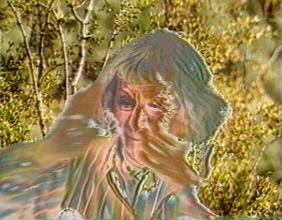Vašulka Mediascape
Steina, Lilith (1987, 9:15)
“Steina’s Lilith uses focal plane shifts and frame-grabbing to enthrall our gaze, to transfix and hypnotize us; then her protagonist, cobra-like, darts across the paradoxical landscape (that has become Steina’s signature), with a sibilant and ambiguous voice; her image inscribes, indelibly, the fact of presence, but – ironically and impossibly – without the content or context of presence.”
Tony Conrad, “Catching Up to Video at Home and Abroad” in Infermental 7 catalog, Buffalo, NY (1988).
“Steina: Doris’ voice is not in any way modulating the video. The video is one stream and her sound another. You see, Doris already had a problem. She was a phenomenal linguist and often used the dictionary as her art material. But she had had a slight stroke, causing some impediment in her speech, and if you were not used to listening to her, she could be hard to understand. Of course I did process her voice too. I am kind of just playing around with this phenomenon, how she was so extraordinarily articulate but hard to understand. In fact, in Lilith, there is no importance to what she is saying but, in not understanding it, it seems to gain an enormous importance.”
Yvonne Spielmann, “An Interview with Steina,” (2003) at Foundation Daniel Langlois website, and in Buffalo Heads, Woody Vašulka & Peter Weibel, eds, ZKM, Karlsruhe (2008); link: https://www.fondation-langlois.org/html/e/page.php?NumPage=417.
